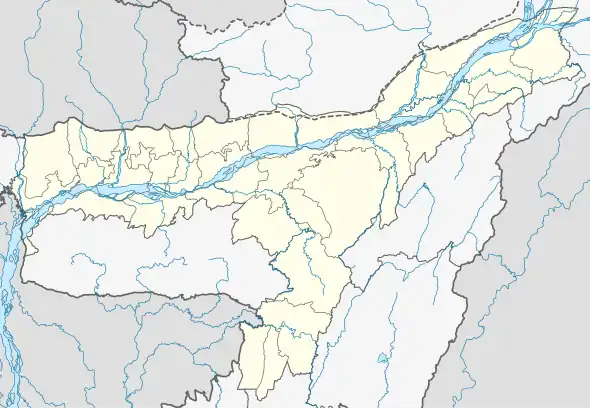North Kamrup violence
North Kamrup violence was a series of violent activities in North Kamrup, Assam, on 4–5 January 1980 between those who supported the Assam Movement and those who opposed it.[1][2][3] Triggered by the death of a high school student, a member of the AASU, it led to a series of attacks and counter-attacks between Assamese and immigrant villages leading to a curfew.[4] According to the Citizenship Rights Preservation Committee, representing Bengali speaking people, the violence was directed against linguistic, religio-linguistic, ethnic minorities and members of the CPI, CPI(M) and CPI(ML) political parties who opposed the Assam Movement.[5] Many of the victims were Miya and it is alleged that the Army committed atrocities on Assamese villagers during the curfew.[6] This was the first reported large-scale group clash during the Assam Movement.[7]
| North Kamrup violence | |
|---|---|
 | |
| Location | North Kamrup, Assam, India |
| Date | 3 January 1980 (UTC+5:30) |
| Target | pro- and anti- Assam Movement |
Attack type | Group clash |
| Weapons | Guns, spears, swords, scythes, bows and arrows |
| Perpetrators | Assamese/Immigrant villagers |
Background
In some districts of lower Assam, Bengali Hindus have experienced violence directed against on the linguistic and cultural identity of the Assamese people.[8]
Assam has been churned in the cauldron of communal, ethnic, and state violence in the name of Assam Movement during 1979 to 1985.[8] Some incidents of them are the North Kamrup pogrom of 1980 in which a large number of people belonging to the linguistic and religious minorities were massacred.
Bengali speaking people were often harassed as foreigners and became the target of violence in the Carly phase of the anti-Bengali movement in Assam.[9] At the beginning of the movement, many Muslim students of East Bengali origin supported and joined the movement.[10] They were pretended themselves as Assamese speaker, called Na Asamiya.[lower-alpha 1][11][10] Although, after some years while Assamese speakers became the majority in Assam along with Muslims who pretended them as Assamese speaker, Assamese people started violence against Bengali speaker including Bengali Hindus. As soon as Muslim immigrants were diplomatically cheated by Assamese people and their community was targeted, they turned against anti-Bengali movement and slowly withdrew their support.[10]
Violence and victimisation
According to one version, on 3 January 1980, a group of students of Baganpara High School were visiting Barikadanga to supervise a three-day strike in response to a call given by the AASU for supporting the anti-Bengali movement.[9] According to another version, the students went there to raise money for the anti-Bengali movement. The village of Barikadanga has a mixed Hindu and Muslim Bangalee population, most of whom are immigrants. They attacked the students as students were there for spreading anti-Bengali movement.
Read also
References
Notes
- The term Na-Asamiya in Assamese language literally means new Assamese, the prefix Na- means new and Asamiya means Assamese. After the Partition of India, the group gave up its Bengali linguistic identity and adopted the Assamese language. Gradually they adopted Assamese culture like gamosa. In English, they are sometimes referred to as Neo-Assamese. Na-Asamiyas also referred to as Charua Musalman, literally meaning Muslims of the chars, because of their preference in settling in the chars.
Citations
- "The referred to the violence of North Kamrup on January 4-5, 1980." (Nayar, Kannabiran & Tarkunde 1986:114)
- Desai, Akshayakumar Ramanlal (1986). Violation of Democratic Rights in India. Popular Prakashan. ISBN 9780861321308.
- Dutta, Nandana (11 September 2012). Questions of Identity in Assam: Location, Migration, Hybridity. SAGE Publications India. ISBN 9788132117001.
- "[T]riggered by the death of a high school student who had worked as a member of the AASU. He was killed in a village inhabited my Muslims of East Bengal origin. His death resulted in a series of attacks and counter-attacks between Assamese and immigrant villages..." (Kimura 2013:69)
- "The violence according to [the Citizenship Rights Preservation Committee] was directed against linguistic, religio-linguistic, ethnic minorities and against the workers of the CPI, CPI(M) and CPI(ML) who opposed the agitation." (Nayar, Kannabiran & Tarkunde 1986:114)
- "Many of the victims were immigrants and it was alleged that the Army had committed atrocities on the Assamese villagers during the curfew under the auspices of carrying out an investigation." (Kimura 2013:69)
- "This was the first large-scale group clash reported during the movement." (Kimura 2013:69)
- Samaddar, Ranabir (1 July 2004). Peace Studies: An Introduction To the Concept, Scope, and Themes. SAGE Publications India. ISBN 9788132102878.
- Bakshi, Shiri Ram; Sharma, Sita Ram; Gajrani, S. (1998). Contemporary Political Leadership in India: Sharad Pawar, the Maratha legacy. APH Publishing. ISBN 9788176480086.
- Kimura (2013)
- Bhaumik, Subir (April 2011). "Risk of durable disorder". Seminar. New Delhi: Seminar Publications (620). Retrieved 10 July 2017.
Bibliography
- Kimura, Makiko (2013). The Nellie Massacre of 1983: Agency of Rioters. Sage Publications India. ISBN 9788132111665.
- Nayar, Kuldeep; Kannabiran, K G; Tarkunde, V M (1986), "The Situation in Assam - A PUCL Report", in Desai, A R (ed.), Violation of Democratic Rights in India, vol. 1, Bombay: Popular Prakashan, pp. 114–120